Text
I GET IT!
I tried 6% * 6% = 0.36%, which was obviously wrong. Nothing added up to 100%. But I have to figure out the total possibilities, and then divide each result by that, not 100!
So 6 * 6 / 3815 = 0.94%
Okay! I can do that with my actual, ugly numbers. Thank you, Papa!
Math question:
I have 6 types of things. I know the percentage of the whole each type takes up. There are 15 specific (2 item) combinations that can be made with these objects. Assuming these are the only combinations possible, and none are easier/harder, how do I figure out how frequently each happens?
Like:
A = 6.6̅% of items, it can be in 4 of the 15 combinations
B = 15% of items, it can be in 5 of the 15 combinations
How do I figure out what percentage of the combinations are likely to be A+B?
#math#SOLVED!#why is life made up of word problems?#having to FIGURE OUT WHICH VARIABLES TO USE is unfair#usually I just phone papa for these sorts of questions#but this felt hard to describe over the phone
9 notes
·
View notes
Note
Saskatoon freezing deaths — is this fucking real? Bc I never heard of it and my Australian friend sent me a wikipedia page, is this seriously real
Yes, it’s real.
Saskatoon cops are racist towards Indigenous people, and this racism kills.
#racism#murder#police brutality#aboriginal#canada#undescribed#convictions require systemic change#because right now white canadians like to pretend that aboriginal people just ... die#that's just part of life#they disappear#or are violently murdered#or freeze to death on the street#and that's just what happens#it's terrifying how normalized horror can get
25K notes
·
View notes
Text
Affordance Widths
Okay. There’s a social interaction concept that I’ve tried to convey multiple times in multiple conversations, so I’m going to just go ahead and make a graph.
I’m calling this concept “Affordance Widths”.
Let’s say there’s some behavior {B} that people can do more of, or less of. And everyone agrees that if you don’t do enough of the behavior, bad thing {X} happens; but if you do too much of the behavior, bad thing {Y} happens.
Now, let’s say we have five different people: Adam, Bob, Charles, David, and Edgar. Each of them can do more or less {B}. And once they do too little, {X} happens. But once they do too much, {Y} happens. But where {X} and {Y} starts happening is a little fuzzy, and is different for each of them. Let’s say we can magically graph it, and we get something like this:
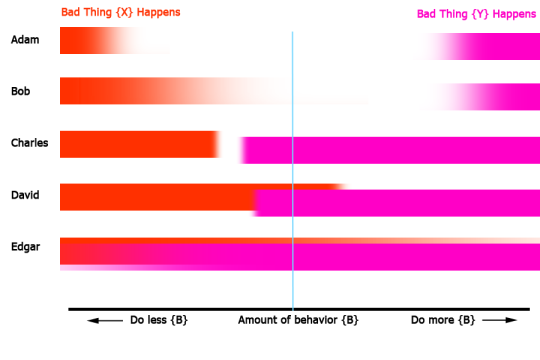
Now, let’s look at these five men’s experiences.
Adam doesn’t understand what the big deal about {B} is. He feels like this is a behavior that people can generally choose how much they do, and yeah if they don’t do the *bare minimum* shit goes all dumb, and if they do a *ridiculous* amount then shit goes dumb a different way, but otherwise do what you want, you know?
Bob understands that {B} can be an important behavior, and that there’s a minimum acceptable level of {B} that you need to do to not suffer {X}, and a maximum amount you can get away with before you suffer {Y}. And Bob feels like {X} is probably more important a deal than {Y} is. But generally, he and Adam are going to agree quite a bit about what’s an appropriate amount of {B}ing for people to do. (Bob’s heuristic about how much {B} to do is the thin cyan line.)
Charles isn’t so lucky, by comparison. He’s got a *very* narrow band between {X} and {Y}, and he has to constantly monitor his behavior to not fall into either of them. He probably has to deal with {X} and {Y} happening a lot. If he’s lucky, he does less {B} than average; if he’s not so lucky, then he tries to copy Bob’s strategy and winds up getting smacked with {Y} way more often than Bob does.
Poor David’s in a situation called a “double bind”. There is NO POSSIBLE AMOUNT of {B} he can do to prevent both {X} and {Y} from happening; he simply has to choose his poison. If he tries Bob’s strategy, he’ll get hit hard with {X} *AND* {Y}, simultaneously, and probably be pretty pissed about it. On the other hand, if he runs into Charles, and Charles has his shit figured out, then Charles might tell him to tack into a spot where David only has to deal with {X}. Bob and Adam are going to be utterly useless to David, and are going to give advice that keeps him right in the ugly overlap zone.
Then there’s Edgar. Edgar’s fucked. There is *NO AMOUNT* of behavior that Edgar can dial into, where he isn’t getting hit HARD by {X} *and* {Y}. There’s places way out on the extreme - places where most people are getting slammed hard by {X} or slammed hard by {Y} - where Edgar notices a slight decrease in the contra failure mode. So Edgar probably spends most of his time on the edges, either doing all-B or no-B, and people probably tell him to stop being so black-and-white about B and find a good middle spot like everyone else. Edgar probably wants to punch those people, starting with Adam.
In any real situation, the affordance width is probably determined by things independent of X, Y, and B. Telling Bob to do a little more {B} than Adam, and Charles to do a little less {B} than Adam or Bob, is great advice. But David and Edgar need different advice - they need advice one meta-level up, about how to widen their affordance width between {X} and {Y} so that *some* amount of {B} will be allowed at all.
In most of the situations where this is most salient to me, {B} is a social behavior, and {X} and {Y} are punishments that people mete out to people who do not conform to correct {B}-ness. A lot of the affordance width that Adam and Bob have would probably be identified as ‘halo effects’.
For example, let’s say {B} is assertiveness in a job interview. Let’s say {X} represents coming across as socially weak, while {Y} represents coming across as arrogant. Adam probably has a lot going for him - height, age, socioeconomic background, etc. - that make him just plain *likeable*, so he can be way more assertive than Charles and seem like a go-getter, *or* seem way less assertive than Charles and seem like a good team player. Whereas David was probably born the wrong skin color and god-knows-what-else, and Edgar probably has some kind of Autism-spectrum disorder that makes *any* amount of assertiveness seem dangerous, and *any* amount of non-assertiveness seem pathetic.
There’s plenty of other values for {B}, {X} and {Y} that I could have picked; filling them in is left as an exercise for the reader.
Does this make sense to people?
5K notes
·
View notes
Text
Yeah, trying to not say FAR too much means I probably didn't say enough.
-
So, different quantities of 6 different items. Only certain pairs are valid - there are 15 valid pairings possible. (For non-math related reasons.) If quantities were equal, all pairings would be equally likely.
100 items:
6 of Type A
22 of Type B
6 of Type C
22 of Type D
15 of Type E
29 of Type F
A and B can be paired with the other types, but not each other. C and D can be paired with the other types, but not each other. E and F can be paired with any type, including their own.
How likely is each pairing?¹
-
I don't need the actual answer (especially since I rounded the numbers off to simplify things), but how do I figure it out?
I ... missed out on learning fractions and percentages in elementary. I still don't quite understand them. I can do great stuff with algebra! I sorta understand matrices! I ... passed calculus. But I look at percentages and get overwhelmed.
-
(¹ The pairings happen because it is a math problem and they happen. Combinations do not need to be explained. They are a technical Math Term! We are not getting into the reasoning. It is dumb fandom stuff and we're not talking about it.)
Math question:
I have 6 types of things. I know the percentage of the whole each type takes up. There are 15 specific (2 item) combinations that can be made with these objects. Assuming these are the only combinations possible, and none are easier/harder, how do I figure out how frequently each happens?
Like:
A = 6.6̅% of items, it can be in 4 of the 15 combinations
B = 15% of items, it can be in 5 of the 15 combinations
How do I figure out what percentage of the combinations are likely to be A+B?
9 notes
·
View notes
Text
WIP excerpt for Cheshire behind the cut; Billy adopts Conner and it actually goes pretty good! ( + non-chrono link for app users )
“Um, yeah,” Billy says, still internally cringing at himself. “Just–not just the bare minimum, I mean? Like–other things too. Books and games and snacks and . . . whatever you think’s fun, or whatever you want to learn about, or whatever.”
He’s definitely been in “homes” that didn’t give him things like that. He doesn’t want Lynn to feel like . . . a burden, or a problem, or just unimportant and unwanted like that, so . . . yeah, he’s definitely gonna get him things that aren’t just the bare minimum. As many of those things as he can, he thinks.
Batman gave them so much money, and that’s not even counting the stipend. Billy can definitely afford to give Lynn the kind of stuff none of his foster families wanted to give him. So, like–he’s gonna, obviously.
Of course he’s gonna.
Lynn ducks his head a little, then swallows uncomfortably. Billy resists the urge to nudge Tawky towards him again. He wonders if he could just, like . . . offer Lynn a hug, maybe? Maybe that’d be okay?
Or maybe it’d be weird and pushy, or maybe stupid, or maybe just make Lynn feel uncomfortable. They’ve never met before today and they’ve barely spent any time together at all, and Billy doesn’t want to be the type of foster parent who demands a relationship that just isn’t there, even if he’s . . . well, not really just a foster parent, he hopes. But those fosters just always made him feel like they were more interested in getting attention and looking good to strangers than anything about him.
He wants Lynn to feel like he’s interested in him–wants Lynn to know he’s interested in him, and cares about him, and isn’t gonna ignore him or hate him if he doesn’t follow some stupid script he’s got in his head of how he “should” be.
He definitely wants that.
“It’s okay if you don’t know what you think’s fun yet,” he tries, hoping he’s not assuming too much. “It’s probably kinda overwhelming, with, um . . . literally everything happening all at once and your whole life getting turned on its head, um . . . basically five minutes after it really started, so . . .”
“I was alive before I woke up,” Lynn says, a little stilted. “I–saw things. Learned things.”
“Things about yourself, or about how Cadmus wanted you to be?” Billy asks.
Lynn–pauses. Frowns.
“. . . um,” he says. “I . . . don’t know.”
Billy is pretty sure Cadmus just sucks, actually. Like. A lot.
“Okay,” he says. “Well, that’s okay too. You can take your time figuring it out. There’s no rush or anything.”
“Superman won’t like me if I don’t figure it out,” Lynn says, his frown deepening. “If I’m not–useful.”
. . . okay, Billy thinks. Cadmus really sucks, actually.
“Superman doesn’t care about people being useful,” he says firmly. “That’s like, the last thing Superman cares about. He just likes people for who they are.”
“. . . who I am is . . . fake, though,” Lynn says, his eyes slanting away. “It’s–programmed.”
“So?” Billy asks, reminding himself superheroes don’t burn down weird basement labs outside of extenuating circumstances. And anyway, the sidekicks already messed Cadmus up pretty bad as it was. “Lots of people get programmed. Red Tornado’s programmed, and he’s really nice. And Wonder Woman got made out of clay as a little kid, so she got, like, magic programming. Like, to be her ‘age’, you know?”
Lynn . . . blinks, slowly, and then glances back at him.
“You really think that?” he asks. Billy’s a little confused by the question. He doesn’t think it; he knows it.
“I mean, yeah?” he says. “I just mean–it doesn’t make you fake. That’s all. Especially ‘cuz you can, you know . . . learn stuff yourself, if you wanna. You don’t have to just stay the way you got taught to be.”
Lynn stares at him for a long, silent moment, then looks down at the table again.
“How long have you had–uh, Uncle Tawky?” he asks, abrupt and obviously trying to change the subject. That’s fine, Billy thinks; he doesn’t want to make him uncomfortable. And Lynn’s gotta learn how to do that kind of thing anyway, so it’s good practice for more complicated conversations, he figures.
“Since I was ten,” he says. “He came from India! I met him in Fawcett, though, and he’s been my best friend ever since! He’s really great. And a respectable gentleman, so you don’t need to be scared of him or anything. I mean, I don’t know if you’re scared of tigers or not? Because probably you’re tiger-proof? Like–normally, I mean. But yeah.”
“. . . I’m not scared of tigers,” Lynn says, looking a little bewildered, for some reason. Billy beams at him.
“Great!” he says happily. Tawky could probably hurt Lynn, since he’s magic too, but he obviously wouldn’t, so he’s just . . . not gonna draw attention to that right now, obviously. That wouldn’t make Lynn feel very safe, he’s pretty sure.
But Tawky could also probably stop Lynn if he got mind-controlled, so . . . maybe it would make him feel safer? Billy’s not sure, actually.
. . . hm. Yeah, he needs to figure that out.
“. . . you’ve really had him since you were ten?” Lynn asks, looking–hesitant, now. Billy doesn’t know why, but nods.
“Yup!” he says. “He’s the best.”
“. . . are you sure you want me to have him?” Lynn asks, still looking hesitant.
“Yeah!” Billy confirms cheerfully. “Tawky’s the best! He’ll protect you. And keep you from having bad dreams, too.” Tawky’s really good at eating nightmares, so yeah, Lynn won’t have to worry about bad dreams at all.
“Uh,” Lynn says, then very gingerly reaches over and picks up Tawky, and then sets him in his lap with a weird look on his face. He looks a little–emotional, maybe? At least for him, anyway. He’s not very expressive, so far. “Um. Okay.”
Billy just beams at him again. He’s really glad they like each other.
“. . . thanks,” Lynn says as he looks down at Tawky, voice a little abrupt again. “Um–Dad."
#people write things#billy batson#young justice (TV)#child abuse#rin remains too good and every story is my favourite
123 notes
·
View notes
Text
So I just saw a post by a random personal blog that said “don’t follow me if we never even had a conversation before” and?????? Not to be rude but literally what the fuck??????????
I’ve had people (non-pornbots) try to strike conversation out of nowhere in my DMs recently, and now I’m wondering if they were doing that because they wanted to follow me and thought they needed to interact first. I feel compelled to say, just in case, that it’s totally okay to follow this blog (or my side blog, for that matter) even if we’ve never talked before.
Also, I’m legit confused. Is this how follow culture works right now? It was worded like it’s common sense but is that really a thing?
#this site can be used SO MANY ways#other than copying someone's post and pretending it's yours (“reposting”) there aren't many that are wrong#of COURSE you're free to follow me#or not and just get caught up every few weeks#I enjoy the like spam!#you can send me messages#or not#I'll probably respond#but talking is hard#if people are pressuring you to use the site in certain ways I'm sorry#you can even tag 'previous' instead of showing me the actual tags#or screenshot things I would prefer to be text#I can handle mild annoyance
35K notes
·
View notes
Text
Nightwing #9 (2016)
I am aware this is just me reading the story for what I want to see in it but you know what? I got through all of n52, I deserve this.

Dick can’t even say to himself that Tim is dead. He can’t spell out his feelings.

He then summons Tim and Clark in his dreams. LOOK at the Tim he summons. That’s his annoying little brother.
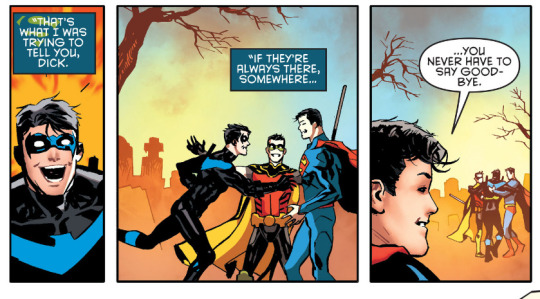
And this is his response. Look at his face. Look at how happy he is.

And then we get this ‘I summoned everyone in my mind’ scene and look who is closest to Dick? Even though this is ostensibly a Superman story (and both Clarks are on his right hand side), Tim’s closest and guarding his side.
78 notes
·
View notes
Text
Give her muscles, if makes sense for the character
give her some fat
maybe add some body hair
but also recognize when you're adding those things because you think they're sexy. Changing the sexual lens is valid, but isn't "desexualizing" a character
let her hair be something other than perfectly groomed
focus the art on a thing she's doing, rather than her body itself
really! Figure out what you want the art to say! It gets a lot less sexy if you have an actual goal other than "draw girl"
let "attractive" parts of her be partially obscured
especially with teen characters, it's occasionally fine to make their boobs smaller. Just understand that it isn't necessary. Varying bodytypes in an ensemble cast is a GOOD thing!
My redesign hot take is that if you’re aiming to “desexualize” a female character, don’t make her boobs smaller. You’re implying a lot here.
41K notes
·
View notes
Text
11. The story is a channel to work through something going on in your life. By seeing what you put down, you can get insight into what you are experiencing.
12. You aren't skilled enough for the stories you DO want to share, so this one is writing practice.
13. You're practicing respecting yourself. Rather than brushing off something that interested you, you are taking the time to put it into words - acknowledging that your interests have value.
why write a story if no one's going to read it?
Sometimes you don't want to share a story with others. Sometimes you do want to share it, but no one clicks on the title. So why bother writing it down if the only person you can guarantee will read it is you?
You need to get it out of your head. It just keeps replaying in your imagination on a loop and the only way to get it unstuck is to pin it down on paper.
You need to figure out what the story is. You have a lot of disjointed scenes or lines that you know are connected but you can't quite figure out how.
There's something in the story that's important to you, and you don't want to lose that thing by forgetting it. Future you might find that thing important too.
You want to be able to go back to the story again and again. Maybe to make adjustments over time. Maybe just to revisit a story that gives you the emotional release you need in that moment.
You want to be able to use text-to-speech to read the story aloud to you. Maybe it's a bedtime story. Maybe it's keeping you company while you do errands and chores.
You want to find out whether you can write a story (because not everyone can).
You want to be able to have almost the same story, but a little bit different, and you want to have it 15 times with slight variations. Then you can go through your own personal menu picking exactly the combination of beats that will satisfy you most on this reading.
You enjoy the process of finding just the right words or phrases or scenes to paint the pictures you want to shape the scene.
You want to find the exact rhythm and syllables and structure to make a sentence really sing.
You don't really have any particular reason, but you know you want to write that story down.
7K notes
·
View notes
Text
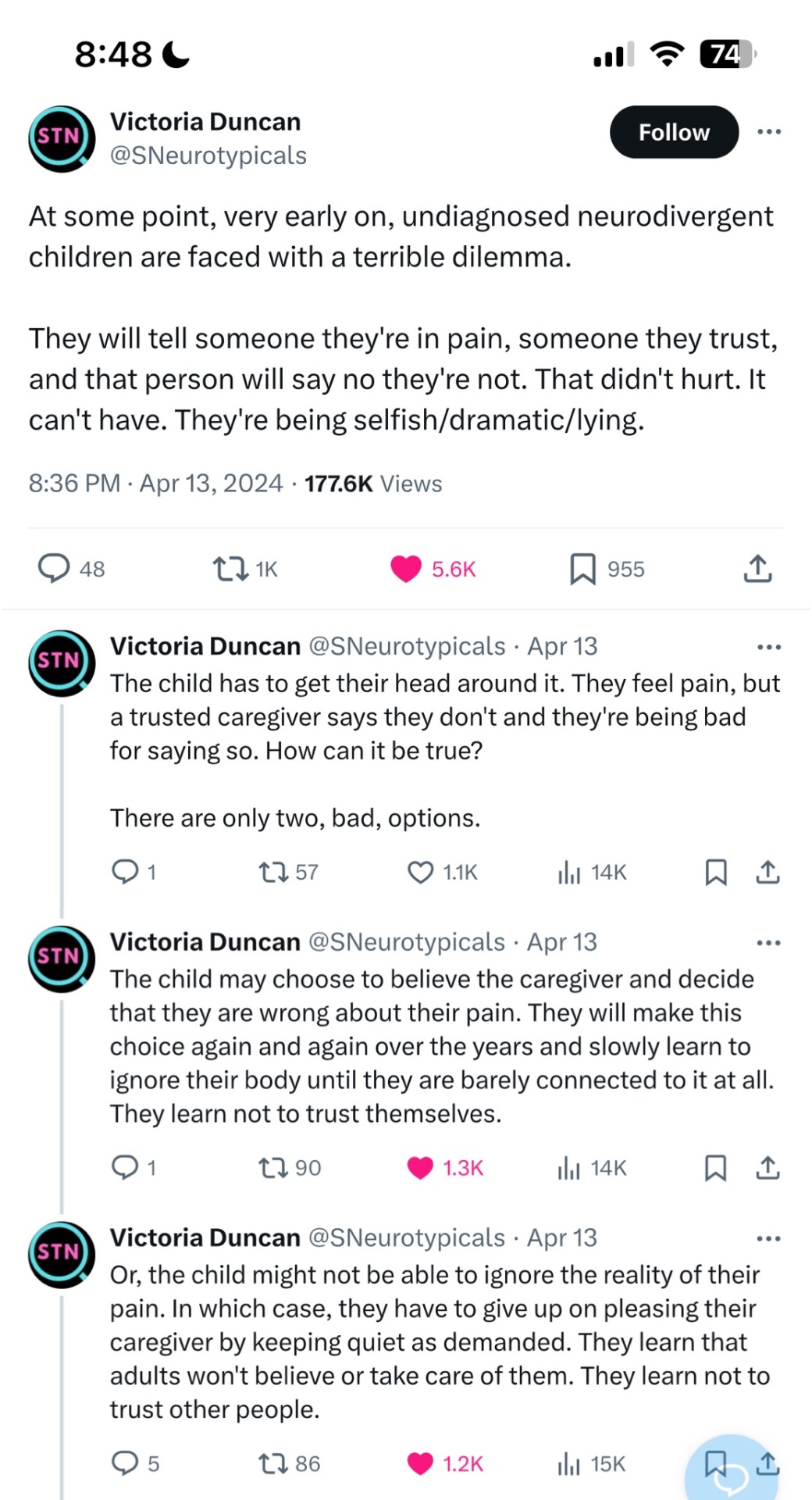
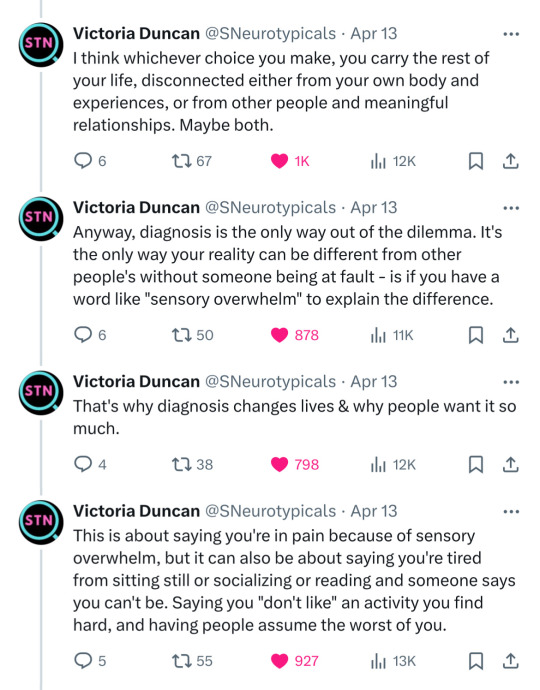
#neurodivergence#child abuse#imagining your child's reality is HARD#especially when empathy HURTS due to your own trauma in the same area#many parents make the easier choice#and let the kid suffer for it
17K notes
·
View notes
Text
I couldn’t form a habit until my son started medication. Getting HIM his meds is doable, and I just make sure that my pill box is stacked with his. This affects both my adhd meds which feel good to be on, AND my previous antidepressants which feel TERRIBLE to be off. And if I change my morning schedule, my habit immediately disappears.
But this attitude is STILL the biggest force effecting my ability to take my meds. I’m TERRIFIED that if they’re too effective my husband will pressure me to stop. That my mama will get worried. That if I’m not in crippling pain, my supports will be taken away. That I need to sneak the healing in, under the radar, so it can’t be used against me.
“You found a solution that works great and now you can move on to something else.”
Why can’t anyone understand that there ARE “something else”s, and that many of them are dependent on this support for me to be able to improve them? Sure, in isolation I could experiment with tapering off my meds once I stabilize. See how much of my increased ability will remain now that I’ve learned what it feels like. But why does that need to be my top priority? Why can’t I BENEFIT from my meds, and use the focus and clarity to build housework habits? Or to support my kids’ mental health?
Why can’t my own priorities be respected?
The other day I told a friend of mine that I never forget to take my ADHD meds because I fucking love my ADHD meds. I'm in my late 30s, I didn't finally get a diagnosis and meds until less than two years ago, and they have changed my entire life.
And he raised his eyebrow at me. We'd been discussing addictive medications a few minutes before, like the Tramadol I finally got from the pain specialist to take once a week or so to give me a break from my chronic pain, so I reassured him that methylpenidate (Ritalin/Concerta) is not addictive (at least not in people with ADHD).
His response? To raise his eyebrow even harder and say "Well it sure SOUNDS like it's addictive!"
And I had to explain to this man - who works in a healthcare related job by the way - that just because medication makes you feel good and helps you, just because you look forward to taking it, that doesn't make it addictive or dangerous. And he wasn't convinced.
The simple fact that I was excited to take a daily pill that has literally changed my life, after decades of fighting to get that medication, made him think I shouldn't be taking it so often. That it must inherently be dangerous.
I'm not even in America, but I'm pretty sure this attitude began there and then spread over here to Europe. This Puritan idea of "if something feels good, you must beware of it. Pleasure is dangerous, it is sinful, it is addiction, it is evil."
I know too many people who subconsciously believe that pleasure = addictive = dangerous = bad. Joy is a slippery slope to hell.
So here is your reminder for today that you don't need to be afraid of feeling good. If something improves your life, use it. Even if it is addictive - learn what that addiction means, whether the addiction is inherently dangerous or not, and whether the benefits outweigh the drawbacks and risks.
My ADHD meds are, in fact, not addictive. But I will take them every day because they make my life orders of magnitude easier. I will enjoy them every time I take them.
My tramadol is addictive. I will still take it. I will keep it on a schedule to avoid becoming addicted, primarily because addiction in this case would mean reduced effectiveness. But I am not afraid of my painkillers. They are life changing.
Take your meds, everyone. Don't let anyone scare you away from doing something that improves your life.
35K notes
·
View notes
Text
A persons fanfic tells you a lot about them, i , a fanfic writer, realize in terror
#for Kieron:#that you spend a LOT more time thinking about the people around you’s emotions#than they do thinking about yours
144K notes
·
View notes
Text
The old school lack of transparency on tumblr is amazing because you assume the people you follow must all be equivalent to you and then you see someone write “I brought my youngest to college today” and someone else write “my mom wouldn’t let me listen to Ariana Grande when I was a kid” and then your head explodes
#there are advantages of being with people who have a similar age and experience level to you#there are so many MORE advantages of being with people of wildly different backgrounds and experiences and seeing what's possible#but we can only enjoy those advantages if we feel safe enough to explore#otherwise it's just being surrounded by danger
100K notes
·
View notes
Text
succumbing to the eternal scientist’s vice of thinking, if I just add more samples to my data, Surely a signal will arise from the noise
42 notes
·
View notes
Note
How old are the bats supposed to be?
During which period? There are variations depending on what time period you're reading.
Pre-Crisis? As at COIE, characters are roughly these ages:
Bruce is in his early 30s
Barbara is in her mid 20s
Dick is 19 or just 20 (depends which side of Crisis you put NTT18)
Jason is 13ish years old
Post-Crisis? (1986-2011) This is the clearest and most consistent period, with regular markers of the progress of time. As at Flashpoint, characters are about these ages:-
Bruce is probably 42
Barbara is in her mid-late 20s
Helena B. is in her mid-late 20s
Kate Kane is in her mid-late 20s (at MOST. Her timeline doesn't make sense otherwise)
If JPV was alive, he'd be 25ish
Dick is about 24-25
Cass is 20 years old
Jason is 19 years old
Steph is 18 years old
Tim is 17 years old and probably about to turn 18
Damian is 10 years old
(the middle kids' ages are all based on Tim being close to a birthday. Cass is 6 months older than Jason, Jason's birthday is a month after Tim's. If Tim's a long way from a birthday, Cass may still be 19)
Then we get the New 52 (2011-2016) and everyone's ages are indeterminate but young! This is my best approximation from not enough age markers and the entire period being about a year in-universe.
Bruce is somewhere between 28-32 (deep sigh)
Kate Kane is probably about 28 years old (it depends on how old Bruce is and how old he was when his parents died; she's younger than he is but not by much)
Julia Pennyworth is in her mid 20s
Barbara is 22-23 years old
Dick is 22 years old
Jason is 20-21 years old, and definitely 21 by the end of the period (SIGH)
Luke Fox is about 20 years old
Tim is 16 years old
Cass is an indeterminate teenage age, probably 16-17
Steph is 16 years old
Harper is 16-17 years old
Duke is, you guessed it, 16ish years old
Damian is 10-11 years old
This is why I don't like New 52 ages.
As of Rebirth (2016 to date), the timeline gets about 10-12 years reinserted in it and some sanity in terms of ages and age gaps starts to re-emerge (though it's clumpy and there's a lot of varying indications). At present characters are approximately these ages:-
Bruce is in his mid 40s
Kate Kane sure is An Age. She's probably about 28-30, unless she's in her late 30s/early 40s (look. Kate's age makes absolutely no sense. Do not look at it too closely. Her timeline is not coherent matched against anyone else's, given the requirement she was kicked out of West Point)
Barbara is probably around 30ish
Dick is about 28-30 years old
Jason is probably about 23-25 years old depending on timeline and writing.
Luke Fox? I haven't sussed out what they've done to all the Fox Kid Ages again in the wake of John Ridley's retcons. He appears to be in his 20s right now.
Cass is supposed to be 23-24 years old but may be written anywhere down to 16.
Steph is somewhere between 19-22, depending on if the writers remember she's not 16 today
Tim is probably anywhere between 18/19 (practical lower limit) and 21 years old
Duke is probably still around 17-19 years old
Damian is 14.
This whole section is messy as the only definite age we have at the moment is Damian being 14. It's mostly assumed that ages have returned to the Post-Crisis gaps, except where noted otherwise (Tim probably lost 1-2 years in his age gap to Damian as of Rebirth, as he is definitely 16 years old at the start of Rebirth. Jason seems to have kept a extra year or few in his gap to Tim, rather than it being 2 years)
#OOOH!#someone has REBIRTH data???#do you happen to have any issue numbers for when Damian's age was stated? or any other post-flashpoint age?#I'd like to add them to my timeline#still nice to see if not
56 notes
·
View notes
Note
Hey, would you be willing to elaborate on that "disappearance of the Anasazi is bs" thing? I've heard something like that before but don't know much about it and would be interested to learn more. Or just like point me to a paper or yt video or something if you don't want to explain right now? Thanks!
I’m traveling to an archaeology conference right now, so this sounds like a great way to spend my airport time! @aurpiment you were wondering too—
“Anasazi” is an archaeological name given to the ancestral Puebloan cultural group in the US Southwest. It’s a Diné (Navajo) term and Modern Pueblos don’t like it and find it othering, so current archaeological best practices is to call this cultural group Ancestral Puebloans. (This is politically complicated because the Diné and Apache nations and groups still prefer “Anasazi” because through cultural interaction, mixing, and migration they also have ancestry among those people and they object to their ancestry being linguistically excluded… demonyms! Politically fraught always!)
However. The difficulties of explaining how descendant communities want to call this group kind of immediately shows: there are descendant communities. The “Anasazi” are Ancestral Purbloans. They are the ancestors of the modern Pueblos.
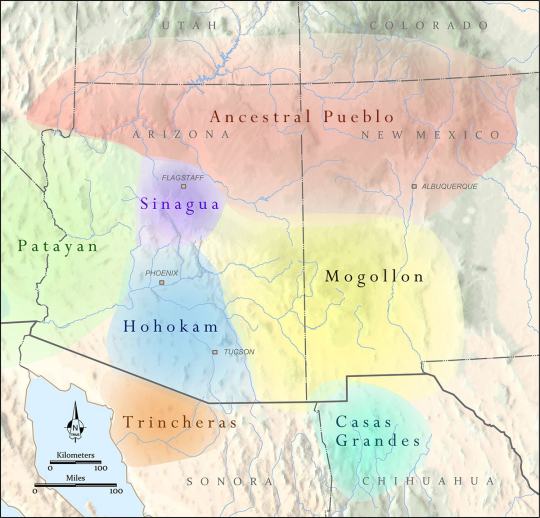
The Ancestral Puebloans as a distinct cultural group defined by similar material culture aspects arose 1200-500 BCE, depending on what you consider core cultural traits, and we generally stop talking about “Ancestral Puebloan” around 1450 CE. These were a group of people who lived in northern Arizona and New Mexico, and southern Colorado and Utah—the “Four Corners” region. There were of course different Ancestral Pueblo groups, political organizations, and cultures over the centuries—Chaco Canyon, Mesa Verde, Kayenta, Tusayan, Ancestral Hopi—but they generally share some traits like religious sodality worship in subterranean circular kivas, residence in square adobe roomblocks around central plazas, maize farming practices, and styles of coil-and-scrape constructed black-on-white and black-on-red pottery.
The most famous Ancestral Pueblo/“Anasazi” sites are the Cliff Palace and associated cliff dwellings of Mesa Verde in southwestern Colorado:


When Europeans/Euro-Americans first found these majestic places, people had not been living in them for centuries. It was a big mystery to them—where did the people who built these cliff cities go? SURELY they were too complex and dramatic to have been built by the Native people who currently lived along the Rio Grande and cited these places as the homes of their ancestors!
So. Like so much else in American history: this mystery is like, 75% racism.
But WHY did the people of Mesa Verde all suddenly leave en masse in the late 1200s, depopulating the whole Mesa Verde region and moving south? That was a mystery. But now—between tree-ring climatological studies, extensive archaeology in this region, and actually listening to Pueblo people’s historical narratives—a lot of it is pretty well-understood. Anything archaeological is inherently, somewhat mysterious, because we have to make our best interpretations of often-scant remaining data, but it’s not some Big Mystery. There was a drought, and people moved south to settle along rivers.
There’s more to it than that—the 21-year drought from 1275-1296 went on unusually long, but it also came at a time when the attempted re-establishment of Chaco cultural organization at the confusingly-and-also-racist-assuption-ly-named Aztec Ruin in northern New Mexico was on the decline anyway, and the political situation of Mesa Verde caused instability and conflict with the extra drought pressures, and archaeologists still strenuously debate whether Athabaskans (ancestors of the Navajo and Apache) moved into the Four Corners region in this time or later, and whether that caused any push-out pressures…
But when I tell people I study Southwest archaeology, I still often hear, “Oh, isn’t it still a big mystery, what happened to the Anasazi? Didn’t they disappear?”
And the answer is. They didn’t disappear. Their descendants simply now live at Hopi, Zuni, Taos, Picuris, Acoma, Cochiti, Isleta, Jemez, Laguna, Nambé, Ohkay Owingeh, Pojoaque, Sandia, San Felipe, Santa Clara, San Ildefonso, Tamaya/Santa Ana, Kewa/Santo Domingo, Tesuque, Zia, and Ysleta del Sur. And/or married into Navajo and Apache groups. The Anasazi/Ancestral Puebloans didn’t disappear any more than you can say the Ancient Romans disappeared because the Coliseum is a ruin that’s not used anymore. And honestly, for the majority of archaeological mysteries about “disappearance,” this is the answer—the socio-political organization changed to something less obvious in the archaeological record, but the people didn’t disappear, they’re still there.
146 notes
·
View notes
Text
I tried asking r/MathHelp for assistance. My post was autodeleted for breaking a rule within half a second of posting and is no longer available to adapt so that it DOESN'T break the rule. (I did not know I had to save questions in a separate Word document so that only copies get eaten by the beast!) The rule is very ambiguous and I can't find anywhere that expands on what's meant. I can't ask, because no human gets a chance to see my questions.
Reddit may have slightly too high of a learning curve for me.
7 notes
·
View notes